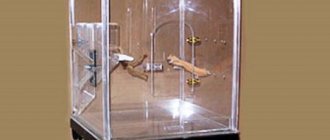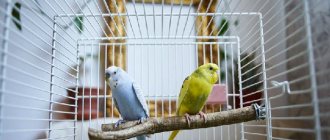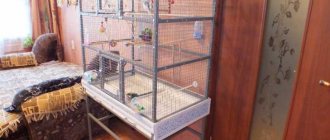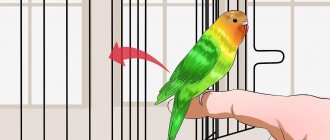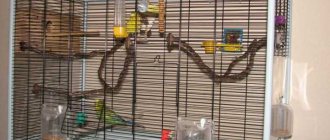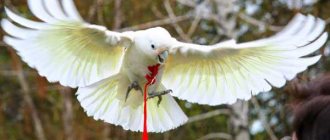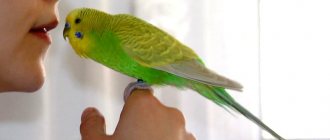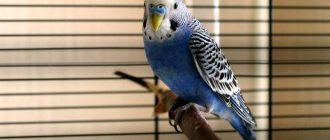Is it necessary to let a parrot out of its cage to fly?
Walking is the most important part in maintaining the activity and physical health of any bird that flies freely in the wild, stretching and keeping its wings and entire skeletal apparatus in good shape.
There is not much space in a room, and even more so in a cage, and therefore it is under no circumstances possible to make a recluse out of a fluttering charmer. His life is not too long anyway, how can we not let him enjoy life!
Should you let your parrot out of its cage?
If there is a lot of active movement, digestion works much better, metabolism occurs without failures, and the overall tone remains high. And being locked up causes excessive drowsiness, apathy, and a variety of illnesses.
The main thing is that the pet loses its taste and interest in life. Nothing can cheer him up, nothing pleases him. Therefore, the chick needs to fly a lot, even within the same room.
The owner must feel enormous responsibility. For each promenade, you need to properly prepare the bridgehead: close all the windows, remove dangerous objects that could injure a curious but careless baby.
It is advisable to permanently remove poisonous plants outside the apartment or house. And, of course, think in advance about how you will have to return the bird to the cage, so as not to drive it into stress from fright.
Security measures
To prevent the flight from ending badly, the owner needs to prepare a space for the bird to walk.
To do this, you should take a number of security measures:
- Close windows, vents, doors so that the pet does not fly out into the street.
- Cover glass and mirrors with cloth: a bird can crash into them with all its might.
- Isolate domestic cats and dogs in another room.
- Remove household appliances and cover wires.
Birds are released into the wild only during the daytime. A pet flying around the apartment should always be in full view of its owner. The parrot must spend the night in its house.
On a note! In case of any danger, a person must be nearby and provide immediate assistance to the pet. You should put your pet parrot in its cage in time, as soon as it starts to get dark.
First flight: when and how to release a parrot for the first time?
First, let the newcomer acclimatize, let him get used to unfamiliar objects, to a stranger who offers him food. Everyone needs to get used to a new place, be it a cat, a dog or an aquarium fish, especially a feathered flying creature.
Read also
Is it necessary to cover a budgie at night
? At least a week, or even two, the parrot will sit in a cage. You can imagine the joy of the first flight in a new home!
How to properly release a parrot for the first time to fly
Birds are usually released daily for two or three hours during daylight hours. The cages are cramped, as zealous new owners try to equip their pet with everything necessary and unnecessary. There is no room inside to properly stretch.
While the new baby is adapting, the family needs to prepare a space for safe walks, take care, communicate, talk, and pet the bird.
The parrot will definitely get used to the owner’s hand, from which it receives all the most delicious things plus positive emotions. But until this happens, it is dangerous to release the bird.
The main thing is trust. Only with his help will the fugitive be returned to an overnight stay without incident.
How to make a boy and a girl friends
Parrots who see each other for the first time often show aggression, so it is difficult to establish warm relationships. A person can help the wavy animals while establishing contact.
To do this, follow simple steps:
first there is a quarantine and a period of adaptation to the new place of residence of the second parrot;- birds must be kept in different cages, but within sight;
- the wavy creatures begin to observe each other’s actions, becoming interested in their fellow tribesman;
- usually the period of mutual interest lasts about two weeks, and during this time a person should pay attention to both birds;
- During this period, it is not allowed to play music loudly, shout or show aggression towards birds, which leads to serious stress;
- You need to communicate and play with the birds, which will allow them to relax and calm down, as they will feel safe;
- they should not be released from the cage or left without human presence;
- it is allowed to let them out for a walk, and this often leads to them visiting each other, which indicates a manifestation of sympathy;
- if the owner notices that the birds are beginning to behave friendly with each other, then you can place the female with the male;
- It is not allowed for a boy to hit or bite a female, as this is a manifestation of aggression, so the bird needs to be placed away for a while.
After establishing contact, the birds treat each other with care and reverence, so they look after each other, kiss and dance.
How to train your pet to return to the cage on its own?
If a parrot eats only in its cage, then it willingly returns there. From the very beginning I recommend observing this main rule. Parrots also sleep in their house, on their favorite perch.
How to teach a parrot to return to its cage
Let's say - an excellent habit. It is advisable to develop it in every possible way, starting from the very tender age of the chick. Voluntary return requires training. Any coercion in studying is unacceptable.
Many breeders believe that a fluttering bird can simply be covered with a cage, removing the bottom. What if you miss and injure the little one? In any case, this method is violence. Fright is guaranteed, and trust in the owner will drop.
Next time the poor fellow will shy away from any contact with a person in anticipation of a sudden attack. He will hide from a friendly hand. Even when cleaning your home you can see this condition. It’s easy to lose mutual understanding, but obedience can really be achieved in a purely peaceful way.
Is it possible to house several couples in one cage?
If initially the birds (several males or females) live together, it is necessary to build an aviary for them.
Living together, they build friendly relationships with each other. Conflict situations rarely arise between them, since they are accustomed to sharing the enclosure between several pairs.
But if the bird initially lived at home and was not used to sharing a cage with relatives, then it will react poorly to such a neighborhood. There is a high probability that fights and conflicts will break out.
Even if the enclosure is used to house several pairs, during breeding each pair is placed in a separate cage. Otherwise, there is a possibility that the birds will destroy the nests.
What else you need to know about two males living together, watch the video:
How to return a parrot to its cage if it does not want to come back?
These creatures are extremely disobedient. I want to float in freedom, because in a cage it’s lonely and boring. The owners cannot watch flights and listen to chirping all night long. They have to work in the morning. Therefore, after fruitless attempts to lure the bird of his own free will, violence begins. It seems like everything has been tried.
How to return a parrot to its cage when it doesn't want to
What to do if your pet flies out the window
It is unlikely that a parrot that flies out of a window will survive. Most likely he will become a victim of predators, or freeze in winter. If he nevertheless flew out into the street, you should not despair, but take measures to return him.
Most often, the pet sits on the tree closest to the window. In this case, you can place the cage by first opening the door onto the windowsill or fix it on the balcony. This must be accompanied by luring the bird, tenderly, long and loudly pronouncing its name. Seeing a familiar object and hearing familiar sounds, the bird may return.
How to catch a parrot on the street? The search must be active, and it is advisable to involve all family members in it. Having noticed a fugitive, you need to carefully sneak up on him and try to catch him. For fishing, it is advisable to use a large area of fabric.
It is absolutely necessary to release the feathered pet from its place of detention. Only an untamed parrot should be kept in the cage at all times. But the owner must also know how to return the parrot back to its place of detention.
Previous
Training Why parrots bite and how to wean them off correctly
Attraction with food and toys
There is a very clever way
An hour before the walk, remove all food supplies from the access area. Fasting a little before warming up is even beneficial. Then your appetite will work up and the journey home will be welcome - the freshest and most delicious food awaits you there.
However, you need to follow some rules:
- The treat should be a pet’s favorite, and it must be checked for balance. Nothing from the human table should be offered to birds!
- Place the bait on your palm into the cage. Talk to the parrot, call him by name. Most often it flies up on its own.
- You don't have to demonstrate a desire to keep the flyer locked up. Pour millet (or whatever serves as a delicacy) into your palm and, when the hungry wanderer sits down to eat, carefully move to the target, i.e. to the house.
Ways to return to the cage
The main thing is not to fuss, not to force events, to wait for the manifestation of good will.
If hunger is not so overwhelming that you give up, you can lure the bird with toys. This also helps in situations where the parrot has already become frightened of something, hid in a secluded corner and does not want to come out when called.
Sociability always wins. The fugitive will sit on the offered perch, begin to play, and then you can carefully move the trinket to plant closer to the house.
The main thing is not to scare him away; there is no need to make sudden movements. If your pet loves the sound of a bell, just ring it and he will return to the cage to play with it on his own. Igor Ignatenkov
Creating artificial twilight
When using this method, you will have to catch the bird, so it is better to wear soft cotton gloves.
Creating artificial twilight as a way to return a parrot to its cage
These will not damage the plumage, and the fugitive will not feel the hands that caught him. He won't understand who he should be angry with. Even if it bites, it won’t hurt the owner.
Next in the room you need to cover the window with curtains and turn off absolutely all the lights. It should be completely dark. Then use a flashlight to find the place where the parrot is sitting. You can use a mobile phone.
Hand catching
With a careful but sure movement, grasp the back of the bird, not allowing the wings to open. Then show the pet its home cage by shining a flashlight beam at it. Only then can you return it.
Read also
How to determine the age of a budgerigar
By closing the door, it is better to let the prisoner realize his position, and therefore do not turn on the light for a while, you can even go out for ten minutes. Only then log in and communicate again. The pet probably did not understand what happened to him, who caught him, and will willingly complain to the owner about such arbitrariness.
How to return a budgie to its cage? #Budgey #parrot #care and maintenance lessons
You can overtake a parrot in the dark if you cover it sitting with a light cloth. It's difficult to take off with a rag on your back. Right in this fabric they take him to a perch to rest.
The main thing is not to chase after him, trying to catch such a nimble on the fly with a piece of light material. Even if this succeeds, he will fall and may be injured. Even fractures sometimes happen. The third or fourth time the fugitive will get used to a certain method of catching him, he will stop resisting, because he will understand that it is useless.
Adaptation period
Quarantine lasts at least two weeks, after which the adaptation period begins. To do this, cages with birds are installed in the same room. The wavy animals will be able to see and hear each other well, which will allow them to quickly get used to the presence of a relative.
If the birds communicate, constantly look at each other, and also try to touch a fellow bird through the cage with their paws, then you can let them out for a walk together, but it should be short-lived. If during direct communication the birds do not swear or fight, then they can be placed in the same cage.
What should you not do when trying to catch a parrot?
You cannot catch birds with a net. Very often tragic stories are told about the use of this method: fluff and feathers fly in all directions, even quite serious injuries occur. At a minimum, there will be fear and long-term (if not forever) distrust of the owner.
How to CAGE A PARROT//Care for a budgie//Birds
Why? Because this happens in full light. Thus, it is clearly visible who exactly is showing aggression. For example, a cockatiel will remember humiliation for the rest of its life and, most likely, will find a moment for revenge, and will always shy away from the hands of its owner.
How to choose a boyfriend or girlfriend for a wavy girl
If you initially bought one parrot, then when finding a pair for it, simple rules are taken into account. For this purpose, an individual with a similar color is selected if breeding wavy animals is planned. The male should be older than the female, which will avoid dominance by the girl who shows aggression towards the new bird.
It is recommended to choose a female whose physique is smaller than the boy, otherwise she may peck at the male during the mating season.
